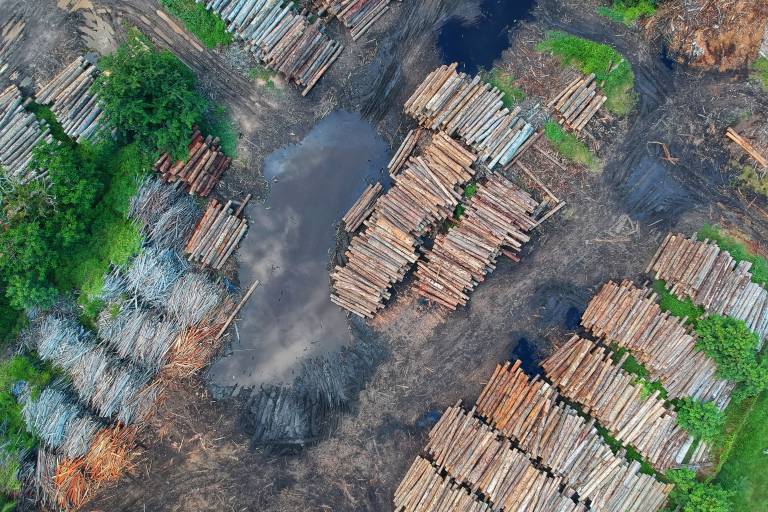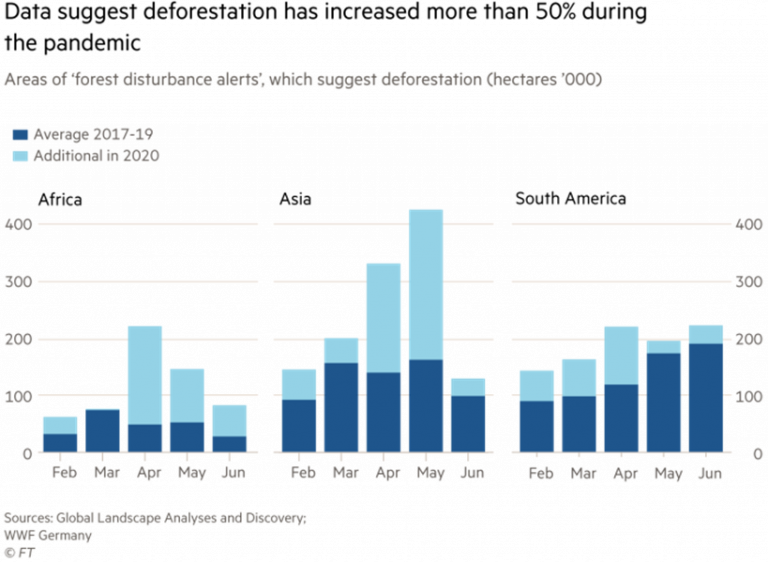Tropical rainforests – a hidden victim of the pandemic?
12 May 2021

The previous decade was a bleak one for tropical rainforests. Deforestation in the 2010s was at least 30% higher than in the 2000s1, and the three years with the highest levels of rainforest loss all occurred in the late 2010s2.
Despite this, the turn of the decade brought cautious optimism. International meetings were scheduled to set new targets covering topics such as zero-deforestation and restoration commitments. This, however, was upended when the COVID-19 pandemic struck.
A chance for nature to recover?
Initially, the pandemic seemed to offer much-needed relief to the natural environment. Images emerged of animals occupying city streets, global noise pollution diminished3, and air pollution largely subsided in many regions as human activity slowed4. Despite the probable short-term nature of these events, one could be forgiven for thinking the pandemic benefitted the natural world.
More than meets the eye…
However, unwelcome impacts became apparent, particularly for tropical rainforests. NGOs pulled their support from field projects, and vital supplementary revenues from ecotourism dried up5. As the pandemic and subsequent economic shock worsened, governments redirected resources towards health and social needs, and away from environmental programmes, such as payment for ecosystem services schemes6.
In response, many rainforest-rich countries relaxed protective legislation covering their forests. In Indonesia, the government introduced deregulation legislation that benefitted palm oil and mining companies5. In Peru, a company under investigation for timber trafficking was rewarded a COVID-19 stimulus package7.
Combined with economic factors, this left rainforests vulnerable. Prices of commodities that drive deforestation, including soy and palm oil, increased during 2020, incentivising production expansion5.
Additionally, opportunistic criminals took advantage of COVID-19-distracted governments to ramp up illegal logging activity, as seen in Malaysia and Brazil8, 9. Such activity also damages indigenous communities, who are vital in maintaining healthy rainforests10.
Overall, these activities have led to considerably higher tropical rainforest deforestation than in previous years, with the pandemic almost certainly playing a part11.

A silver lining?
Optimists would argue that there is yet reason to be hopeful. The emergence of COVID-19 has been a stark warning of the consequences of overexploiting ecosystems, and continued deforestation could initiate similar events12. Experts suggest that such a unique societal shock offers a chance for a green recovery13, although it remains to be seen whether governments will follow suit.
Against an already challenging backdrop for rainforests (e.g. governments signing mandates to lock in deforestation for years14), the additional impact of COVID-19 has been disastrous. If current trends continue, there is a real risk of pushing rainforests past tipping points, leading to effects such as the reversal of rainforests from carbon sinks to carbon sources, and huge biodiversity loss15. Given the importance of rainforests in global atmosphere regulation, this would spell disaster for the planet.
To avoid this, alongside necessary pressure from the private sector, governments must:
- crack down on illegal activity that has driven increased deforestation during the pandemic
- reimplement and expand rainforest protection schemes, such as payment for ecosystem services, and reducing emissions from deforestation16
- build back better - use the opportunity to drive a green recovery that prioritises environmental needs alongside health and social needs, resulting in an overall more resilient and equitable economy
These steps are vital to ensure that this decade is more prosperous for rainforests than the last.
References
- Butler, R. 2020. How much rainforest is being destroyed? Mongabay. Available at: https://news.mongabay.com/2020/06/how-much-rainforest-is-being-destroyed/ (Accessed: 20/02/2021)
- Weisse, M and Goldman, E. D. 2020. We Lost a Football Pitch of Primary Rainforest Every 6 Seconds in 2019. World Resources Institute. Available at: https://www.wri.org/blog/2020/06/global-tree-cover-loss-data-2019 (Accessed 20/02/2021)
- Basu, B. et. al. 2021. Investigating changes in noise pollution due to the COVID-19 lockdown: The case of Dublin, Ireland. Sustainable Cities and Society. Vol. 65. doi: 10.1016/j.scs.2020.102597
- Venter, Z., Aunan, K., Chowdhury, S. Lelieveld, J. 2020. COVID-19 lockdowns cause global air pollution declines. Proceedings of the National Academy of Sciences. 117 (32) pp. 18984-18990. doi: 10.1073/pnas.2006853117
- Butler, R. 2020. How the pandemic impacted rainforests in 2020: a year in review. Mongabay. Available at: https://news.mongabay.com/2020/12/how-the-pandemic-impacted-rainforests-in-2020/ (Accessed: 20/02/2021)
- Zahawi, R., Leighton Reid, J., Fagan, M. 2020. Potential impacts of COVID‐19 on tropical forest recovery. Biotropica. Vol. 52, Issue 5. pp. 803-807. doi: 10.1111/btp.12851
- Praeli, Y. S. 2020. Company investigated for timber trafficking gets stimulus from Peru government. Mongabay. Available at: https://news.mongabay.com/2020/08/company-investigated-for-timber-trafficking-gets-stimulus-from-peru-government/ (Accessed: 21/02/2021)
- Taylor, M. 2020. Deforestation risks rise as coronavirus hinders SE Asia protection. Reuters. Available at: https://www.reuters.com/article/health-coronavirus-deforestation/deforestation-risks-rise-as-coronavirus-hinders-se-asia-protection-idUSL8N2BJ12Z (Accessed: 22/02/2021).
- Butler, R. Despite COVID, Amazon deforestation races higher. Mongabay. Available at: https://news.mongabay.com/2020/04/despite-covid-amazon-deforestation-races-higher/ (Accessed: 23/02/2021)
- Cuffe, S. 2015. To tackle climate change cheaply, first secure indigenous forest rights. Mongabay. Available at: https://news.mongabay.com/2015/11/to-tackle-climate-change-cheaply-first-secure-indigenous-forest-rights/ (Accessed: 22/02/2021)
- Gross, A. G., Schipani, A., Palma, S., Findlay, S. 2020. Global deforestation accelerates during pandemic. Financial Times. Available at: https://www.ft.com/content/b72e3969-522c-4e83-b431-c0b498754b2d (Accessed 23/02/2021)
- Tollefson, J. 2020. Why deforestation and extinctions make pandemics more likely. Nature. Available at: https://www.nature.com/articles/d41586-020-02341-1 (Accessed: 23/02/2021)
- Holland, E. and Perez, K. W. 2020. A green recovery from COVID-19? Not without climate, nature and development solutions. International Institute for Environment and Development. Available at: https://www.iied.org/green-recovery-covid-19-not-without-climate-nature-development-solutions (Accessed: 23/02/2021)
- Butler, R. 2021. Rainforests: 11 things to watch in 2021. Mongabay. Available at: https://news.mongabay.com/2021/01/rainforests-11-things-to-watch-in-2021/ (Accessed 22/02/2021)
- Hanbury, S. 2020. Impending Amazon tipping point puts biome and world at risk, scientists warn. Mongabay. Available at: https://news.mongabay.com/2020/01/impending-amazon-tipping-point-puts-biome-and-world-at-risk-scientists-warn/ (Accessed: 22/02/2021)
- Cannon, J. C. 2019. REDD+ more competitive than critics believe, study finds. Mongabay. Available at: https://news.mongabay.com/2019/09/redd-more-competitive-than-critics-believe-study-finds/ (Accessed: 23/02/2021)
Image credit
https://www.pexels.com/photo/bird-s-eye-view-of-woodpile-1268076/
 Close
Close

